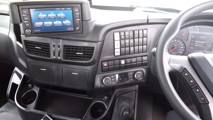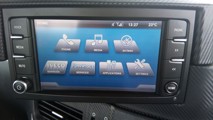Review
Iveco has a great history in the European multi-wheeler sector, based in no small part on its takeover of the famous German truck manufacturer Magirus in the mid-seventies.
The Ulm factory was known for producing high quality, reliable, robust multi-wheelers and, incidentally, excellent fire engines.
Iveco’s more recent history has seen the EuroTrakker taking over the Magirus mantle, offering a split between a ‘muck-away’ targeted product and the aggregate sector.
While there are many differences between these two markets, perhaps the main variation focuses around the heavy duty requirements of the former and this is reflected in the relatively high unladen weight of the chassis.
The Stralis X-Way aims to cater to both sectors in a similar way to EuroTrakker, but with one important difference.
It has an excellent lower kerbweight, helping it to appeal to the aggregate truck operators who were mainly ignored by EuroTrakker.
In fairness, the Stralis X-Way range is extensive and helps it appeal to both ends of the diverse multi-wheeler market.
There’s even tractor/artic versions at 4x2 and 6x4. This diversity is described by Iveco as “mission matching” a term used for many years by the company, and in the case of X-Way this covers seven main areas:
- Mixer
- Tipper
- Hook lifter/skip loader
- Crane/platform
- Tipper semi-trailer
- Timber
- Gully emptier
One area in which Iveco has a global reputation is diesel engine technology through its Fiat Power Train (FPT) division which manufactures engines across the whole industrial sector from agricultural tractors to generators as well as, of course, truck and vans.
At the heart of the X-Way are the Cursor 9, Cursor 11 and Cursor 13 engines which deliver nine different power ratings covering 315PS to 578PS.
The Cursor 9 (8.7-litre) starts at 315PS and 1,300Nm through to 406PS and 1655Nm, Cursor 11 (11.1-litre) starts at 426PS and 1475Nm to 487PS and 1465Nm and finally, the Cursor 13 (12.9-litre) starting at 517bhp and 1,560Nm to 547PS and 1695Nm of torque.
All the engines are Euro VI Stage C-compliant and utilise Iveco’s patented Hi-SCR after-treatment system which achieves a 97% NOx-abatement level without the need for EGR.
For the majority of operations, the latest development of the 12- and 16-speed Hi-Tronix automated will be the gearbox of choice, featuring both direct and indirect drive to match the single or hub reduction rear axles.
Of course, there may be particular operations were an automated gearbox will not be appropriate and, in those cases, customers can specify either a 16-speed manual or Allison automatic.
The chassis frame section is available in 7.7mm thickness or, for operations requiring a potential lower kerb weight, 6.7mm (of course a sub-frame may be required). Wheelbases range from 3,120mm to 6,700mm.
Front axles are rated at nine tonnes and the rear axle options range from three single reduction and three hub reduction rated between 13 tonnes and up to 23 tonnes (not necessarily UK legal) and they sit on either springs or air suspension.
The Stralis X-Way continues with its customisation by offering three bumper set-ups based around the cab access and approach and departure angles, package by Iveco as an On-Road, On+ Road and Off Road set-up with the first two homologated for on-road and the latter for off-road use.
X-Way has quite a diverse appeal and is reflected in the three cab variants available, ranging from a short low roof Active Day (AD) for urban trips, sleeper with low and medium roof Active Time (AT) for regional journeys and top of the range sleeper low and high roof Active Space (AS) for long hauls. The first two cabs are 2,280mm wide and the third slightly wider at 2,460mm.
The three cabs also have different lengths at 1,660mm, 2,100 mm and 2,215mm, finally the floor to roof heights vary from 1,570mm to 2,310mm.
With such a wide choice of variants available, it was difficult to decide what to test, but one vehicle stood out, the new X-Way Super Loader (SL) four-axle mixer chassis complete with a CIFA SLX9 cement mixer.
According to Iveco, the SL version, at around 9,000kg, has the lowest kerb weight in the industry and can also feature the Hi-Traction hydrostatic drive which delivers traction to all four corners without the need (and associated increased weight) for an all-wheel drive system.
Our test vehicle stood out from the crowd, as it’s painted in a very bright and noticeable orange and finished with alloy wheels (saving 165kg) helping to create a quality look.
Climbing up the four steps into the Active Day cab and sitting on the suspended driver’s seat, you are faced with a semi-circular instrument panel featuring the largest array of warning lights (27 in all) as you start up and a prominent Iveco logo in the central LCD panel.
The steering wheel features controls for the telephone, entertainment, cruise control and LCD menu with stalks for the lights and wipers either side.
In the dash, the side panel has a series of rocker switches and the heating and ventilation including an optional climate control.
In the centre panel at the top, there is a prominent LCD screen for the entertainment, telematics and sat-nav system slightly angled towards the driver’s view.
Starting the engine brings a muffled and quiet noise, a quick press of D for drive, and the ZF automatic gearbox takes up the drive with very smooth gear changes.
Mixers are very susceptible to roll when cornering, but the X-Way SL showed no sign of this and suspension worked no different than if it was a tipper or similar.
The Active Day cab had good visibility, especially to the side with the angled side windows, and large rear view mirrors.
Driving along at around 40-50 mph in 11th or 12th gear puts the rev needle in the sweet fuel economy green spot between 1,200-1,700rpm and also in the high torque section.

























